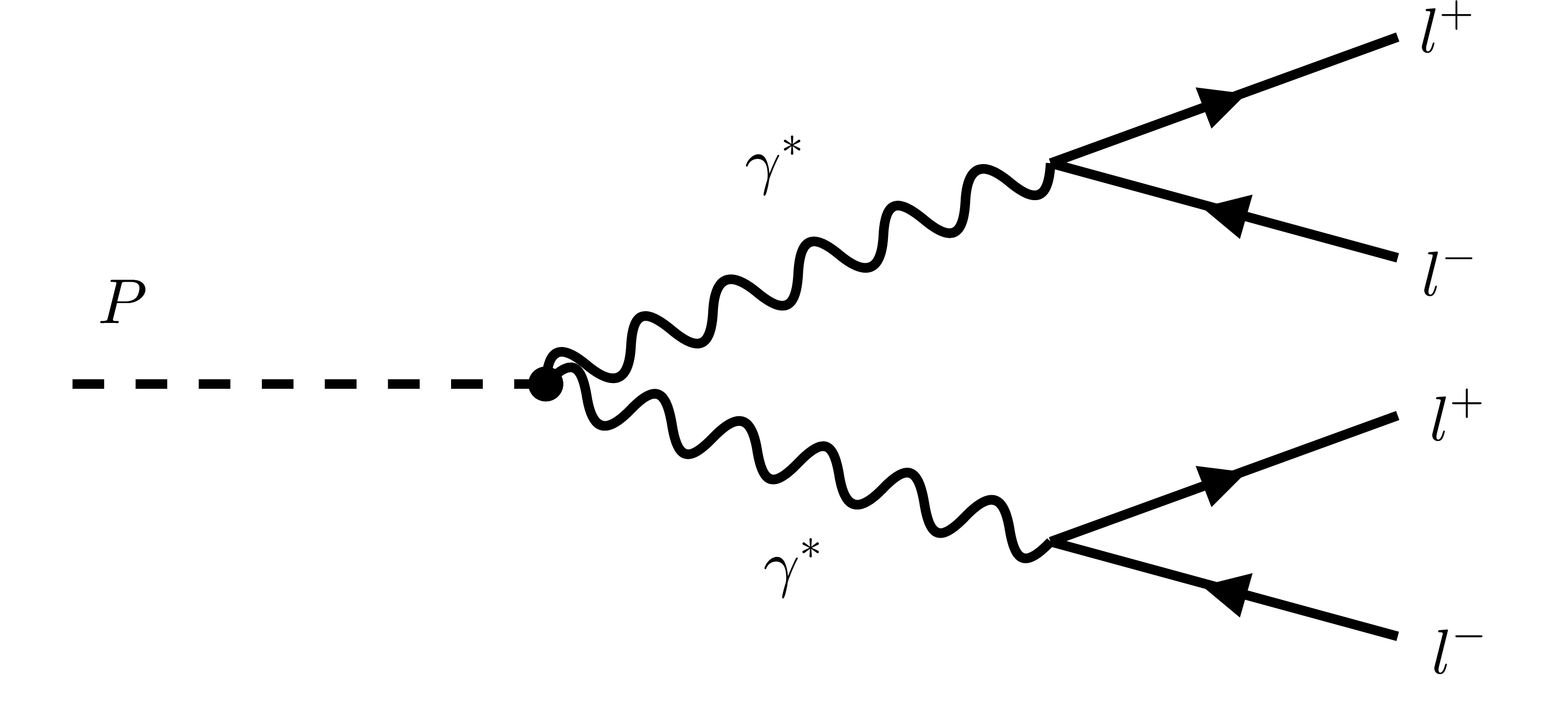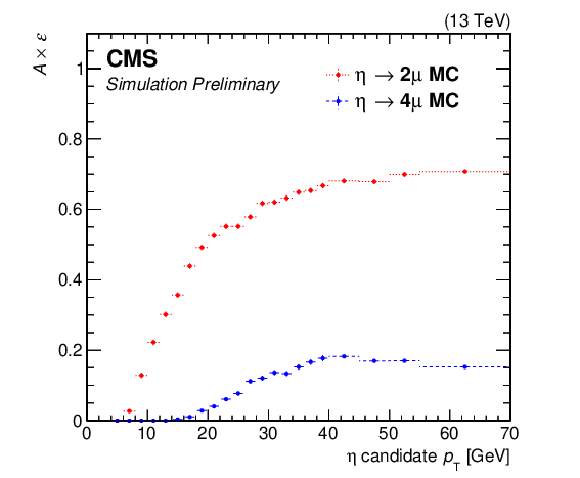

Compact Muon Solenoid
LHC, CERN
| CMS-PAS-BPH-22-003 | ||
| First observation of the rare 4 $ \mu $ decay of the $ \eta $ meson | ||
| CMS Collaboration | ||
| 25 February 2023 | ||
| Abstract: The first observation of the double-Dalitz decay $ \eta \rightarrow \mu^+\mu^-\mu^+\mu^- $ is reported with 2017 and 2018 data by the CMS experiment at the CERN LHC. A signal having a statistical significance well in excess of 5 standard deviations was identified using high-rate muon trigger data collected at a proton-proton collision center of mass energy of 13 TeV corresponding to an integrated luminosity of 101 fb$ ^{-1} $. Using the $ \eta \rightarrow \mu^+\mu^- $ decay as normalization, the branching fraction $ \mathcal{B}(\eta \rightarrow \mu^+\mu^-\mu^+\mu^-) = $(5.0 $ \pm $ 0.8 (stat) $\pm$ 0.7 (syst) $\pm$ 0.7 ($\mathcal{B}$)) $\times$ 10$^{-9} $ is measured, in agreement with theoretical estimates. | ||
|
Links:
CDS record (PDF) ;
Physics Briefing ;
CADI line (restricted) ;
These preliminary results are superseded in this paper, PRL 131 (2023) 091903. The superseded preliminary plots can be found here. |
||
| Figures | |

png pdf |
Figure 1:
Feynman diagrams of pseudoscalar decays into four leptons. The upper graph represents direct contributions to the decay, while the lower graph shows the contributions associated with vector-meson dominance. |

png pdf |
Figure 1-a:
Feynman diagrams of pseudoscalar decays into four leptons. The upper graph represents direct contributions to the decay, while the lower graph shows the contributions associated with vector-meson dominance. |

png pdf |
Figure 1-b:
Feynman diagrams of pseudoscalar decays into four leptons. The upper graph represents direct contributions to the decay, while the lower graph shows the contributions associated with vector-meson dominance. |

png pdf |
Figure 2:
Distributions of $ m_{\mu\mu} $ obtained with the dimuon selection. Black points denote the inclusive $ p_{\mathrm{T}}^{\mu\mu} $ range, blue points denote 10 $ < p_{\mathrm{T}}^{\mu\mu} < $ 11 GeV (with 5x magnification), and red points denote 28 $ < p_{\mathrm{T}}^{\mu\mu} < $ 29 GeV (with 50x magnification). |

png pdf |
Figure 3:
The observed $ m_{4\mu} $ in data with the fit results overlaid. Black points denote the data; the dashed green curve is the background component of the fit, the red dot-dashed curve is the signal component, and the solid blue curve is their sum. The pull on the lower panel is shown relative to the background component of the fit model. |

png pdf |
Figure 4:
CMS $ A{\times}\varepsilon $ of $ \eta \rightarrow 2\mu $ (red) and $ \eta \rightarrow 4\mu $ (blue) decays vs. $ \eta $ candidate $ p_{\mathrm{T}} $, determined in simulation. The $ \eta $ candidate $ p_{\mathrm{T}} $ is the $ p_{\mathrm{T}} $ of the dimuon ($ p_{\mathrm{T}}^{2\mu} $) in the first case and the $ p_{\mathrm{T}} $ of the four-muon combination ($ p_{\mathrm{T}}^{4\mu} $) in the second. |

png pdf |
Figure 5:
Comparison of the four-muon $ p_{\mathrm{T}} $ spectrum observed in data in the window $ m_{4\mu} \in $ [0.53, 0.57] GeV (black points) and the signal prediction from simulation assuming the observed branching fraction (green dashed line). Also shown is the predicted background shape normalized to the background fit yield, whose shape is extracted from the sideband (dotted blue line), and the sum of signal and background predictions (solid red line). |

png pdf |
Figure 6:
Predicted resonant background contributions to the signal mass window, estimated with simplified Monte Carlo simulations. The $ \eta \to \mu^+ \mu^- \mu^+ \mu^- $ signal is displayed as a benchmark (red squares), followed by various other decay modes of the $ \eta $ meson. The curves are normalized to an integrated luminosity of 101 fb$ ^{-1} $. For unobserved decay modes, the current experimental upper limits are conservatively taken as the reference branching fractions. |
| Tables | |

png pdf |
Table 1:
Set of dimuon L1 requirements applied in the high-rate triggers. The angular separation between muons in the $ \eta-\phi $ plane is defined as $ \Delta R \equiv \sqrt{(\Delta\phi)^2 + (\Delta\eta)^2} $. The first L1 path requires a muon $ p_{\mathrm{T}} > $ 4 GeV in 2017 and $ > $ 4.5 GeV in 2018. The third path imposes a separate requirement on each muon $ p_{\mathrm{T}} $. The combined efficiency is about 92%. |
| Summary |
| In summary, the first observation of the double-Dalitz decay $ \eta \rightarrow \mu^+\mu^-\mu^+\mu^- $ is reported. The observation of such rare decays is made possible by the use of CMS data collected with high-rate muon triggers at $\sqrt{s} = $ 13 TeV in 2017 and 2018, corresponding to an integrated luminosity of 101fb$^{-1}$. The branching fraction of the $ \eta \rightarrow \mu^+\mu^-\mu^+\mu^- $ decay is measured relative to the decay $ \eta \rightarrow \mu^+\mu^-$, yielding the ratio (0.9 $\pm$ 0.1 (syst) $\pm$ 0.1 (stat)) $\times$ 10$^{-3}$. Using the world average value of the reference channel, the branching fraction of the target channel is measured as $\mathcal{B}(\eta \to \mu^+ \mu^- \mu^+ \mu^-) =$ (5.0 $\pm$ 0.8 (stat) $\pm$ 0.7 (syst) $\pm$ 0.7 ($\mathcal{B}$)) $\times$ 10$^{-9}$, a precision of 26%. The central value is 25% higher than the SM prediction but still in agreement within the quoted uncertainties. A more precise branching fraction measurement of the reference channel will provide a corresponding stimulus to increase the statistics and improve the signal efficiency modeling of the measurement reported in this note. |
| References | ||||
| 1 | L. Landsberg | Electromagnetic decays of light mesons | Physics Reports 128 (1985) 301 | |
| 2 | R. Abegg et al. | Measurement of the branching ratio for the decay $ \eta \to \mu^+ \mu^- $ | PRD 50 (1994) 92 | |
| 3 | F. Ambrosino et al. | Observation of the rare $ \eta \to e^{+} e^{-} e^{+} e^{-} $ decay with the KLOE experiment | PLB 702 (2011) 324 | 1105.6067 |
| 4 | BESIII Collaboration | Observation of the double dalitz decay $ {\eta}^{'}\rightarrow{e}^{+}{e}^{-}{e}^{+}{e}^{-} $ | PRD 105 (2022) 112010 | |
| 5 | A. Anastasi et al. | Precision measurement of the $ \eta \to \pi^+ \pi^- \pi^0 $ Dalitz plot distribution with the KLOE detector | JHEP 05 (2016) 019 | 1601.06985 |
| 6 | L. Gan, B. Kubis, E. Passemar, and S. Tulin | Precision tests of fundamental physics with $ \eta $ and $ \eta^\prime $ mesons | Phys. Rept. 945 (2022) | 2007.00664 |
| 7 | E. Goudzovski et al. | New physics searches at kaon and hyperon factories | link | |
| 8 | M. Knecht, S. Narison, A. Rabemananjara, and D. Rabetiarivony | Scalar meson contributions to $ a_\mu $ from hadronic light-by-light scattering | PLB 787 (2018) 111 | 1808.03848 |
| 9 | Particle Data Group Collaboration | Review of particle physics | Prog. Theor. Exp. Phys. (2022) 083C01 | |
| 10 | CMS Collaboration | The CMS experiment at the CERN LHC | JINST 3 (2008) S08004 | |
| 11 | CMS Collaboration | Performance of the CMS Level-1 trigger in proton-proton collisions at $ \sqrt{s} = $ 13\,TeV | no.~, P7, 2020 JINST 15 (2020) P10017 |
CMS-TRG-17-001 2006.10165 |
| 12 | CMS Collaboration | The CMS trigger system | JINST 12 (2017) P01020 | CMS-TRG-12-001 1609.02366 |
| 13 | CMS Collaboration | Electron and photon reconstruction and identification with the CMS experiment at the CERN LHC | JINST 16 (2021) P05014 | CMS-EGM-17-001 2012.06888 |
| 14 | CMS Collaboration | Performance of the CMS muon detector and muon reconstruction with proton-proton collisions at $ \sqrt{s}= $ 13 TeV | JINST 13 (2018) P06015 | CMS-MUO-16-001 1804.04528 |
| 15 | CMS Collaboration | Description and performance of track and primary-vertex reconstruction with the CMS tracker | JINST 9 (2014) P10009 | CMS-TRK-11-001 1405.6569 |
| 16 | CMS Collaboration | Search for a narrow resonance lighter than 200 GeV decaying to a pair of muons in proton-proton collisions at $ \sqrt{s} = $ 13 TeV | PRL 124 (2020) 131802 | CMS-EXO-19-018 1912.04776 |
| 17 | CMS Collaboration | Data Parking and Data Scouting at the CMS Experiment | CMS Detector Performance Summary CMS-DP-2012-022, 2012 CDS |
|
| 18 | CMS Collaboration | Search for narrow resonances in dijet final states at $ \sqrt{s} = $ 8\,TeV with the novel CMS technique of data scouting | PRL 117 (2016) 031802 | |
| 19 | I. Fröhlich et al. | Pluto: A monte carlo simulation tool for hadronic physics | PoS ACAT 07 (2007) 6 | 0708.2382 |
| 20 | T. Sjöstrand et al. | An introduction to PYTHIA 8.2 | Comput. Phys. Commun. 191 (2015) 159 | 1410.3012 |
| 21 | CMS Collaboration | Extraction and validation of a new set of CMS PYTHIA8 tunes from underlying-event measurements | EPJC 80 (2020) 4 | CMS-GEN-17-001 1903.12179 |
| 22 | GEANT4 Collaboration | GEANT 4--a simulation toolkit | NIM A 506 (2003) 250 | |
| 23 | R. Frühwirth | Application of Kalman filtering to track and vertex fitting | NIM A 262 (1987) 444 | |
| 24 | J.E. Gaiser | Charmonium Spectroscopy from Radiative Decays of the J$/\psi $ and $ \psi $ | PhD thesis, SLAC (1982) link |
|
| 25 | S. Baker and R. D. Cousins | Clarification of the use of chi-square and likelihood functions in fits to histograms | NIM Phys. Res. 221 (1984) 437 | |
| 26 | CELSIUS/WASA Collaboration | Measurement of $ \eta $ meson decays into lepton-antilepton pairs | PRD 77 (2008) 032004 | 0711.3531 |
| 27 | B. Borasoy and R. Nißler | $ \eta,\eta{^\prime} \to \pi^+\ell^+ \ell^- $ in a chiral unitary approach | EPJA 33 (2007) 95 | 0705.0954 |
| 28 | R. Escribano and S. Gonzàlez-Solís | A data-driven approach to $ \pi^0 $, $ \eta $ and $ \eta^\prime $ single and double Dalitz decays | Chinese Phys. C 42 (2018) 023109 | 1511.04916 |

|
Compact Muon Solenoid LHC, CERN |

|

|

|

|

|

|